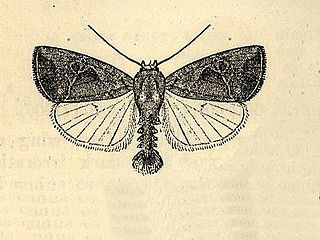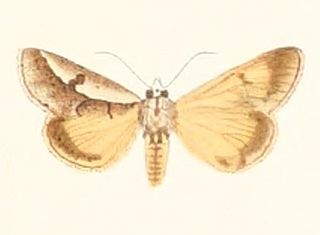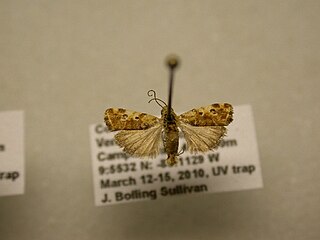Related Research Articles

The Cuban macaw or Cuban red macaw was a species of macaw native to the main island of Cuba and the nearby Isla de la Juventud that became extinct in the late 19th century. Its relationship with other macaws in its genus was long uncertain, but it was thought to have been closely related to the scarlet macaw, which has some similarities in appearance. It may also have been closely related, or identical, to the hypothetical Jamaican red macaw. A 2018 DNA study found that it was the sister species of two red and two green species of extant macaws.

Elaphria nucicolora, the sugarcane midget, is a moth of the family Noctuidae. The species was first described by Achille Guenée in 1852. It is found from the south-eastern United States, through Guadeloupe, Jamaica and Puerto Rico to tropical South America. It is also present on the Hawaiian islands of Oahu, Maui and Hawaii.
Lepidomys irrenosa is a species of snout moth in the genus Lepidomys. It was described by Achille Guenée in 1852 and is known from the United States, including Florida, Georgia and South Carolina. It is also found on Cuba.

Spragueia apicalis, the yellow spragueia, is a moth of the family Noctuidae. The species was first described by Gottlieb August Wilhelm Herrich-Schäffer in 1868. It is also found in North America, Central America, Cuba and Peru.

Orodesma apicina is a species of moth in the family Erebidae first described by Gottlieb August Wilhelm Herrich-Schäffer in 1868. The species is found in Florida, Central America and Cuba. It is sometimes recorded in Great Britain through accidental importation in produce.

Elaphria agrotina is a moth of the family Noctuidae first described by Achille Guenée in 1852. It is found from North America, through Central America, the Antilles and Cuba to Brazil and Argentina.
Eutelia furcata, the Florida eutelia moth, is a moth of the family Noctuidae. The species was first described by Francis Walker in 1865. It is found from the southern United States to Mexico, Cuba, Puerto Rico and Central America.
Coenipeta medina is a species of moth in the family Erebidae first described by Achille Guenée in 1852. The species is found from Texas through Central America and Cuba to Brazil.

Caenurgia chloropha, the vetch looper moth, is a moth of the family Erebidae. The species was first described by Jacob Hübner in 1818. It is found in the south-eastern United States, northern Mexico and Cuba. Strays may be found as far north as southern Ontario.

Phaloe cubana is a moth in the subfamily Arctiinae first described by Gottlieb August Wilhelm Herrich-Schäffer in 1866. It is found in Central America, Mexico and Cuba.

Euscirrhopterus poeyi, the pullback moth, is a moth of the family Noctuidae. The species was first described by Augustus Radcliffe Grote in 1866. It is found from southern Florida and Mexico, through Central America to Brazil. It is also found in the Caribbean, including Cuba.
Catabenoides vitrina is a moth of the family Noctuidae first described by Francis Walker in 1857. It is found from California to western Texas and south through Mexico to Central America. It is also found in the Caribbean, including Cuba.

Callopistria floridensis, the Florida fern moth or Florida fern caterpillar, is a moth of the family Noctuidae. It is found from North America, south through the Caribbean, Mexico and Central America to Ecuador.

Spragueia perstructana is a moth of the family Noctuidae first described by Francis Walker in 1865. It is found from the United States, south to the Caribbean and Central America, including Costa Rica.

Orthodes majuscula, the rustic Quaker, is a moth of the family Noctuidae. The species was first described by Gottlieb August Wilhelm Herrich-Schäffer in 1868. It is widespread throughout the New World, including eastern North America, Cuba, Mexico, Costa Rica and Brazil.

Melipotis acontioides, the royal poinciana moth, is a species of moth in the family Erebidae. It was first described by Achille Guenée in 1852. The species is found from the southern United States through Mexico and Central America to Brazil, Argentina and the Galápagos Islands. It is also found in the Caribbean, including Cuba and the British Virgin Islands, Jamaica and Puerto Rico.
Horama pennipes is a moth in the subfamily Arctiinae first described by Augustus Radcliffe Grote in 1866. It is found on Cuba.
Phoenicoprocta capistrata is a moth in the subfamily Arctiinae. The species was first described by Johan Christian Fabricius in 1775. It is found in the Caribbean and Brazil.

Condica punctifera is a moth of the family Noctuidae first described by Francis Walker in 1857. It is found in southern Florida and on the Bahamas, Cuba, Jamaica, Hispaniola and Puerto Rico.
Epidromia lienaris is a moth of the family Erebidae first described by Jacob Hübner in 1823. It is found from southern Florida and Arizona southward through the Caribbean and Central America to Peru and Brazil and the Galápagos Islands.
References
- ↑ Becker, Vitor O. (2002). "The Noctuoidea (Lepidoptera) from Cuba described by Herrich-Schäffer and Gundlach in the Gundlach Collection, Havana" (PDF). Revista Brasileira de Zoologia. 19 (2): 349–391. Archived from the original (PDF) on April 29, 2013. Retrieved March 7, 2012.
- ↑ U.S. Forest Service
| This Ctenuchina-related article is a stub. You can help Wikipedia by expanding it. |